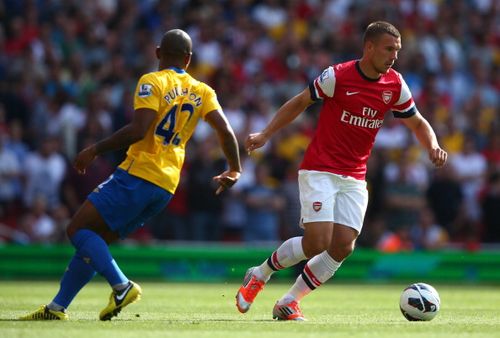
The death of a winger

The winger is a vital cog in the football wheel and it’s no surprise that the past few years have seen wingers fetch enormous prices in the transfer window. In fact, some of the most valuable players in the world today are some form of wingers. The reason I say “some form of wingers” is because the role and position of the winger seems to have blurred over generations. The lines of distinction between winger, playmaker and attacker have faded over time as players that are positioned wide now engage in multi-faceted roles for their teams.
Traditionally, the winger was a player who would burst down the byline with pace and skill and deliver that telling cross to his attacker to finish off the move. He would play up the field and had little or no defensive responsibilities. However, all of that seems to have changed with the passage of time. Modern football is currently looking over the traditional winger on his deathbed, his extinction only inevitable.
The modern winger is far more dynamic and offers more than just that single dimension of his predecessor. Although he starts off in the same wide positions, he cuts inside in order to support the strikers, as opposed to hitting the byline and supplying the deep cross. In fact, a report by UEFA highlighted how out of the 103 goals for strikers in the 2010-11 campaign of the Champions League only a mere 3 were headed goals. That should give you an insight into the evolution of the traditional deep?crossing winger into a more central moving attacking figure.
Why has that happened you ask?
Well, for several reasons actually.

‘Possession Play’ for one. The modern game heavily emphasizes on keeping more possession of the ball and not giving it away cheaply. As a result, teams now look to play the ball along the ground more. Aerial passes run a greater risk of losing possession and so the wide players prefer to dribble in to more central positions rather than play the deep cross. Stoke City, for example, are not a possession based side. Therefore they play two wingers in Jermaine Pennant and Matthew Etherington, both of whom generally figure in the top 5 crossers in the Premier League. However, this style of play has often resulted in the team being caught isolated out wide.
The rise of the wing backs is another huge reason. Take Philipp Lahm and Dani Alves for example. Both generally play in more advanced roles for the team acting as another mode of attack. They provide the additional width for the team by acting as wide outlets on the flanks.
Wing backs are constantly looking to get a touch of the ball and move the play forward. Most of the wing backs in the world today enjoy a fair deal of possession of the ball in almost every single game. A look at the top passers in Europe figures several wing backs with Lahm and Alves racking up almost 77 passes per game on average. Thus, by employing the wing backs in such a role, teams ensure that they aren’t caught out on the flanks.
Perhaps the only pure wingers in the Premier League that play alongside such a system are Gareth Bale and Antonio Valencia, who put in an average of 1.3 and 1.7 crosses per game respectively. However there are several arguments that state that their style of play, although effective, can get too one-dimensional at times. While they are both exceptionally good at what they do, they represent a playing style that seems to be heading to horizons of irrelevance in modern football.
The Consequence?
The birth of a new breed of Wide Forwards.

They start off in wide positions but drift centrally into a support striker role. This trend dominates football today because of its ability to wreak havoc in the opposing defense. The dilemma that arises is whether the full back marking the wide forward should follow him inside or whether to leave that job to his holding midfielder. Decoy runs from an attacking wing back only adds to the confusion, making this form of flank play a deadly weapon in the arsenal of any great team today.
The game has gotten significantly quicker, tighter and smarter than football in the days of the past. This has resulted in a greater burden of expectation on players to affect the game. Thus, the traditional winger just simply cannot continue to contribute against the stingy defensive systems that are in place today. While the Bales and Valencias of the world offer rays of hope for the persistence of the pure winger, their single-dimensional styles will only be able to do so much against a disciplined defence. The question of their replacement is only inevitable as more and more teams seek out wide players that can influence their game in a multitude of ways. Therefore it can only be described as the end of the line in the journey for the traditional winger. For every evolution, there must be extinction. A new wide forward is born; the pure winger is all but dead.